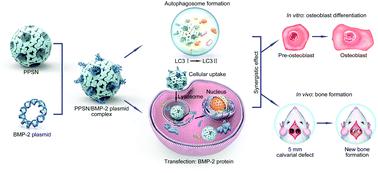Our official English website, www.x-mol.net, welcomes your
feedback! (Note: you will need to create a separate account there.)
Bone formation promoted by bone morphogenetic protein-2 plasmid-loaded porous silica nanoparticles with the involvement of autophagy.
Nanoscale ( IF 5.8 ) Pub Date : 2019-10-25 , DOI: 10.1039/c9nr07017f Xiaowei Xu 1 , Maolei Sun , Dandan Wang , Wenhuan Bu , Zilin Wang , Yuqin Shen , Kai Zhang , Ding Zhou , Bai Yang , Hongchen Sun
Nanoscale ( IF 5.8 ) Pub Date : 2019-10-25 , DOI: 10.1039/c9nr07017f Xiaowei Xu 1 , Maolei Sun , Dandan Wang , Wenhuan Bu , Zilin Wang , Yuqin Shen , Kai Zhang , Ding Zhou , Bai Yang , Hongchen Sun
Affiliation

|
Gene therapy is one of the most common and effective ways for the regeneration of defective bone tissue, but even highly efficient gene delivery vectors are insufficient. In this study, bone morphogenetic protein-2 plasmid (pBMP-2) was encapsulated by polyethylenimine-modified porous silica nanoparticles (PPSNs), which were synthesized via an ethyl ether emulsion method. Owing to the high specific surface area and high absorption characteristics, low cytotoxicy PPSNs can efficiently load and protect pBMP-2. The resulting PPSN/pBMP-2 can transfect MC3T3-E1 cells effectively to promote osteogenic differentiation and increase calcium deposition in vitro. Interestingly, the mass of calcium deposition nodules decreased dur to the presence of an autophagy inhibitor, demonstrating that PPSNs stimulated the autophagy pathway. Because of their excellent biocompatibility, high transfection efficiency, and ability to stimulate autophagy, the as-prepared PPSN/pBMP-2 could efficiently transfect local cells in a defect area in vivo. Micro-computed tomography and histological images demonstrated that PPSN/pBMP-2 could efficiently promote new bone formation in a 5 mm sized rat calvarial defect model. Taken together, our newly synthesized PPSNs could efficiently carry pBMP-2 and deliver it to the target cells as well as stimulating the autophagy pathway, resulting in significant osteogenic differentiation and bone regeneration.
中文翻译:

骨形态发生蛋白2质粒加载多孔二氧化硅纳米粒子与自噬的参与促进了骨形成。
基因疗法是再生有缺陷的骨组织的最普遍和有效的方法之一,但是即使高效的基因递送载体也是不足的。在这项研究中,骨形态发生蛋白2质粒(pBMP-2)被聚乙烯亚胺修饰的多孔二氧化硅纳米粒子(PPSN)封装,该粒子通过乙醚乳液法合成。由于具有高的比表面积和高吸收特性,低细胞毒性的PPSN可以有效负载和保护pBMP-2。所得的PPSN / pBMP-2可以有效转染MC3T3-E1细胞,以促进成骨分化并增加体外钙沉积。有趣的是,由于存在自噬抑制剂,钙沉积结节的质量降低了,这表明PPSNs刺激了自噬途径。由于其优异的生物相容性,高转染效率和刺激自噬的能力,因此制备的PPSN / pBMP-2可以在体内有效转染缺损区域的局部细胞。显微计算机断层扫描和组织学图像表明,PPSN / pBMP-2可以在5毫米大小的大鼠颅盖骨缺损模型中有效促进新骨的形成。综上所述,我们新合成的PPSN可以有效携带pBMP-2并将其递送至靶细胞,并刺激自噬途径,从而导致显着的成骨分化和骨再生。
更新日期:2019-10-25
中文翻译:

骨形态发生蛋白2质粒加载多孔二氧化硅纳米粒子与自噬的参与促进了骨形成。
基因疗法是再生有缺陷的骨组织的最普遍和有效的方法之一,但是即使高效的基因递送载体也是不足的。在这项研究中,骨形态发生蛋白2质粒(pBMP-2)被聚乙烯亚胺修饰的多孔二氧化硅纳米粒子(PPSN)封装,该粒子通过乙醚乳液法合成。由于具有高的比表面积和高吸收特性,低细胞毒性的PPSN可以有效负载和保护pBMP-2。所得的PPSN / pBMP-2可以有效转染MC3T3-E1细胞,以促进成骨分化并增加体外钙沉积。有趣的是,由于存在自噬抑制剂,钙沉积结节的质量降低了,这表明PPSNs刺激了自噬途径。由于其优异的生物相容性,高转染效率和刺激自噬的能力,因此制备的PPSN / pBMP-2可以在体内有效转染缺损区域的局部细胞。显微计算机断层扫描和组织学图像表明,PPSN / pBMP-2可以在5毫米大小的大鼠颅盖骨缺损模型中有效促进新骨的形成。综上所述,我们新合成的PPSN可以有效携带pBMP-2并将其递送至靶细胞,并刺激自噬途径,从而导致显着的成骨分化和骨再生。


















































 京公网安备 11010802027423号
京公网安备 11010802027423号